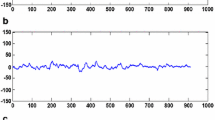Abstract
Segmentation and labelling of time series is a common requirement for several applications. A brain computer interface (BCI) is achieved by classification of time intervals of the electroencephalographic (EEG) signal and thus requires EEG signal segmentation and labelling. This work investigates the use of an autoregressive model, extended to a switching multiple modelling framework, to automatically segment and label EEG data into distinct modes of operation that may switch abruptly and arbitrarily in time. The applicability of this approach to BCI systems is illustrated on an eye closure dependent BCI and on a motor imagery based BCI. Results show that the proposed autoregressive switching multiple model approach offers a unified framework of detecting multiple modes, even in the presence of limited training data.
Access this chapter
Tax calculation will be finalised at checkout
Purchases are for personal use only
Preview
Unable to display preview. Download preview PDF.
Similar content being viewed by others
References
Camilleri, T., Camilleri, K., Fabri, S.: Automatic detection of spindles and K-complexes in sleep EEG using switching multiple models. Biomedical Signal Processing and Control 10, 117–127 (2014)
Dempster, A.P., Laird, N.M., Rubin, D.B.: Maximum Likelihood from Incomplete Data via the EM Algorithm. J. R. Stat. Soc. 39(1), 1–38 (1977)
Fabri, S.G., Kadirkamanathan, V.: Functional Adaptive Control - An Intelligent Systems Approach. Springer (2001)
Ghahramani, Z., Hinton, G.E.: Parameter Estimation for Linear Dynamical Systems. Technical report CRG-TR-96-2, Department of Computer Science, University of Toronto (1996)
Hoffman, G.S.: A Novel Electocardiogram Segmentation Algorithm using a Multiple Model Adaptive Estimator. Master’s thesis, Air Force Institute of Technology, Graduate School of Engineering and Management, Ohio (2002)
Maybeck, P.S.: Stochastic Models, Estimation and Control. Mathematics in Science and Engineering. Academic Press Inc., London (1979)
Maybeck, P., Stevens, R.: Reconfigurable flight control via multiple model adaptive control methods. IEEE Trans. on Aerosp. and Electron. Syst. 27(3), 470–480
Pardey, J., Roberts, S., Tarassenko, L.: A Review of Parametric Modelling Techniques for EEG Analysis. Med. Eng. Phys. 18, 2–11 (1996)
Sajda, P., Gerson, A., Muller, K.R., Blankertz, B., Parra, L.: A data analysis competition to evaluate machine learning algorithms for use in brain-computer interfaces. IEEE Trans. Neural Syst. Rehabil. Eng. 11(2), 184–185 (2003)
Sanei, S., Chambers, J.: EEG Signal Processing. John Wiley & Sons, Inc. (2007)
Schomer, D.L., Lopes da Silva, F.H. (eds.): Niedermeyer’s Electroencephalography: Basic Principles, Clinical Applications, and Related Fields, 6th edn. Lippincott Williams & Wilkins (2010)
Thuraisingham, R.A., Tram, Y., Boord, P.A.C.: Analysis of eyes open, eye closed EEG signals using second-order difference plot. Medical and Biomedical Engineering and Computing 45, 1243–1249 (2007)
Townsend, G., Graimann, B., Pfurtscheller, G.: Continuous EEG classification during motor imagery-simulation of an asynchronous BCI. IEEE Trans. Neural Syst. Rehabil. Eng. 12(2), 258–265 (2004)
Author information
Authors and Affiliations
Corresponding author
Editor information
Editors and Affiliations
Rights and permissions
Copyright information
© 2015 Springer International Publishing Switzerland
About this paper
Cite this paper
Camilleri, T.A., Camilleri, K.P., Fabri, S.G. (2015). Segmentation and Labelling of EEG for Brain Computer Interfaces. In: Azzopardi, G., Petkov, N. (eds) Computer Analysis of Images and Patterns. CAIP 2015. Lecture Notes in Computer Science(), vol 9256. Springer, Cham. https://doi.org/10.1007/978-3-319-23192-1_24
Download citation
DOI: https://doi.org/10.1007/978-3-319-23192-1_24
Published:
Publisher Name: Springer, Cham
Print ISBN: 978-3-319-23191-4
Online ISBN: 978-3-319-23192-1
eBook Packages: Computer ScienceComputer Science (R0)




